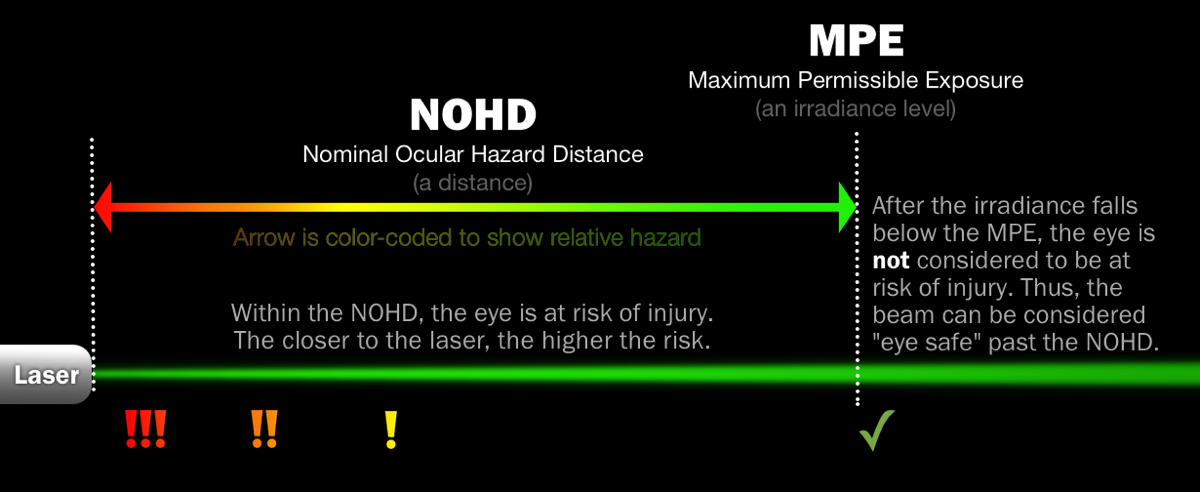Home
A comprehensive resource for safe and responsible laser use

NOTICE: CALCULATOR WILL NOT WORK
This calculator will not work with Internet Explorer. You appear to be running Internet Explorer or another incompatible browser; if so, all the results will be “.0”.
To allow this calculator to work, please use an up-to-date version of a browser such as Microsoft Edge, Mac Safari, Google Chrome, Firefox, etc. If you continue to have problems, contact us.
Beam Diameter and Irradiance Calculator
We also have a full-featured Laser Hazard Distance Calculator, with the NOHD, ED50, and FAA visual interference distances.
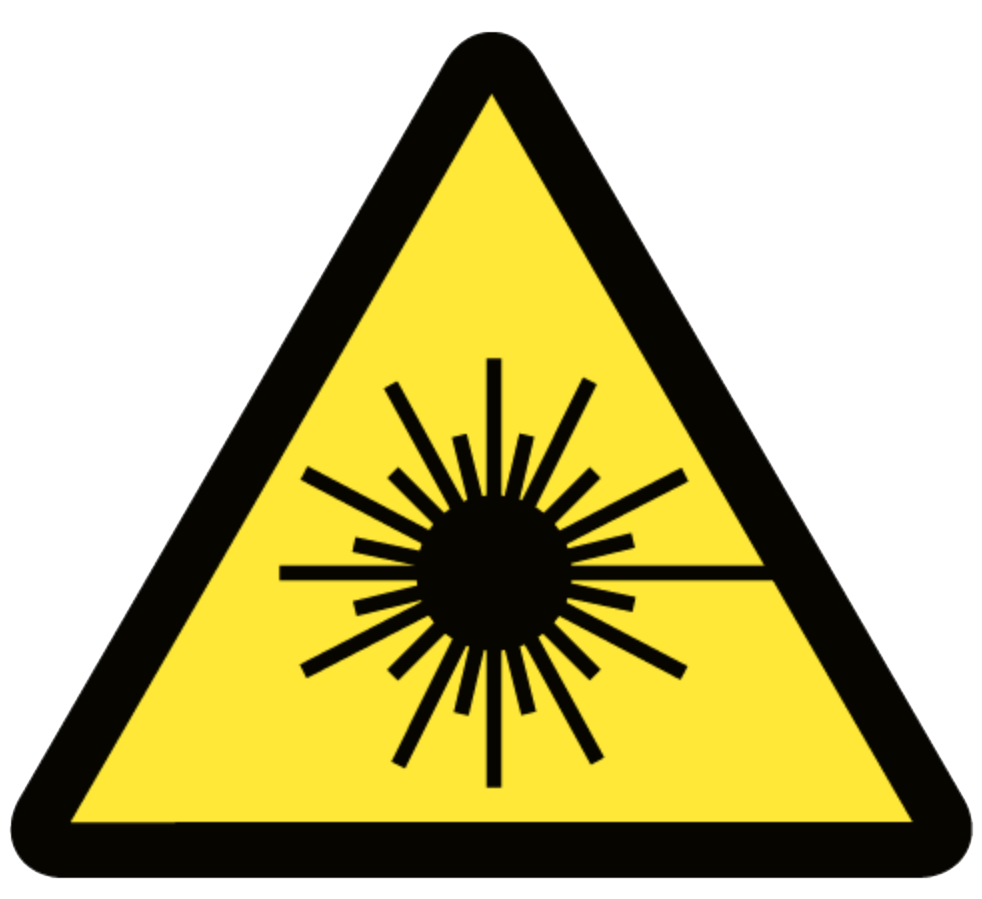
If you know the power in watts, multiply the watts by 1000 to get milliwatts. For example, for a 1 watt laser, enter 1000; for a 1.5 watt laser, enter 1500; for a 40 watt laser enter 40000.
-
How is the "beam diameter" defined?
- Most laser beams used in pointers and light shows are Gaussian. This means they are brightest in the center and they fall off towards the edges. The center is the “worst case” area for an eye to be located.
The diameter listed here is the area where 63% of the beam power is contained, called the “1/e width.”
Specifically, “the distance between diametrically opposed points in that cross section of a beam where the power per unit area is 1/e (0.368) times that of the peak power per unit area.” This definition comes from the laser safety standard ANSI Z136.1.
FDA, FAA and ANSI all use this technique for reporting and analyzing irradiance.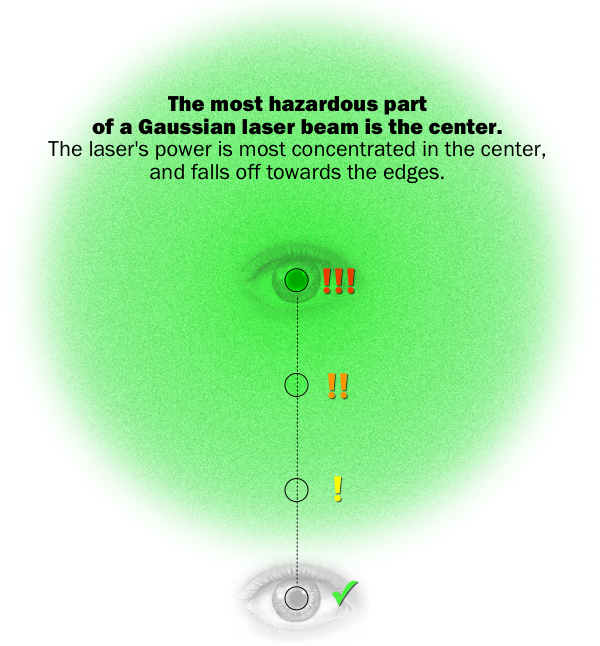

-
If the irradiance is greater than 2.5 mW/cm²
- If the calculated irradiance above is greater than 2.5 mW/cm2, then the laser light is a potential eye hazard.
According to laser safety experts, the Maximum Permissible Exposure (MPE) for the eye to continuous wave visible laser light for a 1/4 second exposure is 2.5 mW/cm2. This assumes that a person will blink, turn away or otherwise stop the exposure within 1/4 second.
If the calculated irradiance is greater than around 25 mW/cm2 then the laser light is a probable eye hazard. It could cause retinal injury even if a person turned away within 1/4 second.
The higher the irradiance, the greater the eye hazard. At 100 or more times the MPE, there will definitely be an injury — the higher the irradiance, the more severe the injury.
The above assumes all of the laser beam enters the eye, and that the beam remains relatively steady on the retina. If not all of the laser beam enters the pupil, and/or if the laser beam moves relatively fast over the retina, then the injury potential would be less. -
Maximum allowed irradiance values (MPEs)
- The Maximum Permissible Exposure varies depending on the laser's operating mode (continuous wave or pulsed), wavelength, exposure duration, and whether the exposure is to Eye, Skin or materials.
This calculator uses the Eye MPE for continuous wave visible laser light with an exposure duration of 1/4 (0.25) second. This MPE is 2.5 mW/cm2.
Why 1/4 second? Laser safety experts picked 1/4 second as the duration when there is accidental, unwanted eye exposure to visible light. A person is expected to blink and/or turn away within 1/4 second.
For longer exposures, the Eye MPE will be less (dimmer light). Conversely, for shorter exposures, the MPE will be greater (brighter light).
Calculating exact Eye MPE values
For eye exposures between 18 microseconds (18 μsec or 0.000018 sec) and 10 seconds, you can use the following formula to determine the continuous wave visible light MPE, where t is the time of exposure in seconds:(t 0.75 x 1.8) ÷ t
The answer will be in mW/cm2.
To calculate t to the 0.75 power, use a scientific calculator with a "xy" button. Enter the time in seconds, press the xy button, then 0.75, then the equals button.
Below is an example showing a calculator app with an xy button, and how to calculate the MPE for a 3 second duration.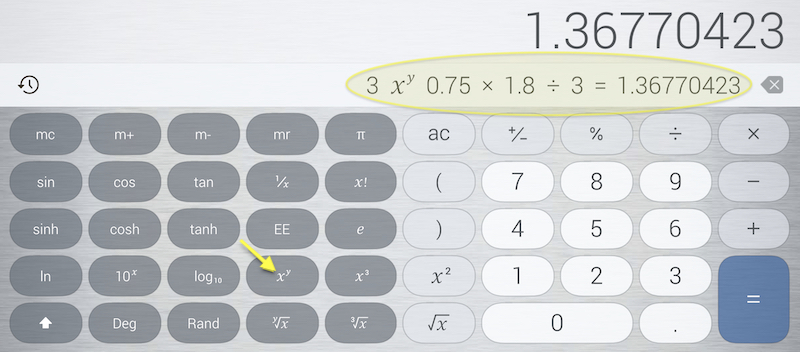
Selected Eye MPE values
Here are some Eye MPE values for selected exposure durations. These are the maximums; you are not allowed to exceed this value, for the exposure duration listed.- 10 seconds: 1.01 mW/cm2
- 1 second: 1.80 mW/cm2
- 0.25 second: 2.5 mW/cm2. This value is used for accidental, unwanted exposure to visible light, where a person is expected to blink and/or turn away within 1/4 second of experiencing a bright light.
- 0.1 second: 3.20 mW/cm2
- 0.01 second: 5.69 mW/cm2
- 0.001 second: 10.1 mW/cm2
- 0.0001 second: 18.0 mW/cm2
- 0.000018 microseconds: 27.6 mW/cm2
For longer exposures such as 10 minutes or 8 hours, the MPE is wavelength dependent. For example, the Eye MPE for a 10 minute exposure to red 633 nm laser light is 0.253 mW/cm2; for blue-green 514 nm laser light it is 0.0167 mW/cm2.
The formula and values come from the laser safety standard ANSI Z136.1. -
To convert mW/cm² to W/m² or W/cm²
- In the U.S., milliwatts per square centimeter is most commonly used. But elsewhere watts per square meter, or watts per square centimeter are often used.
Milliwatts per square centimeter <-> Watts per square meter- To convert mW/cm2 to W/m2, multiply by 10. For example, 2.5 mW/cm2 equals 25 W/m2.
- To convert W/m2 to mW/cm2, divide by 10. For example, 25 W/m2 equals 2.5 mW/cm2.
Milliwatts per square centimeter <-> Watts per square centimeter- To convert mW/cm2 to W/cm2, divide by 1000. For example, 2.5 mW/cm2 equals 0.0025 W/cm2.
- To convert W/cm2 to mW/cm2, multiply by 1000. For example, 0.0025 W/cm2 equals 2.5 mW/cm2.
-
The center of the beam is the most hazardous
- Most laser beams used in pointers and light shows are Gaussian. This means they are brightest in the center and they fall off towards the edges. The center is the “worst case” area for an eye to be located.

-
If your results don't match…
- If you do laser safety calculations using different sources, you might find that results from one calculator or equation or computer program might not exactly match up with results from another.
Generally, if the results are within about 5% or less of each other, this is OK. To be on the safe side, use the value that is more conservative.
For example, if one calculator says the NOHD of a particular laser is 560 meters, and another says it is 567 meters, use the longer distance (further from the laser and thus safer).
Why results can vary
Results can vary due to using slightly different values for certain constants. For example, the MPE for a 1/4 second exposure might be 2.5, 2.54 or 2.55 mW/cm2 depending on the calculator or equation source.
Or, a factor such as the initial width of the beam may be ignored when calculating safety distances many meters from the laser aperture, since it has little effect over long distances.
Finally, safety concepts such as the NOHD etc. are not exact. If a calculator determines the NOHD is “567.5 meters”, this does NOT mean that your eyes will be damaged at 567.4 meters but will be safe at 567.6 meters.
Rounding is OK
In fact, saying the NOHD is “567.5” gives a false impression of precision. In this case it would be fine to round up the NOHD (make it slightly longer) to 570 meters.
Note: The calculator on this page does not round because the underlying code cannot handle sophisticated rounding. Results are always given to 4 decimal places because sometimes we need the decimal places (“0.0516”) even though many times we don’t (“3,271.1039” is just too precise!).
Starting at the NOHD distance, laser light directly entering the eye is at the Maximum Permissible Exposure (MPE) and is generally considered safe. Specifically, at the NOHD there is “a negligible probability of damage” according to the laser safety standard ANSI Z136.1.
The farther one gets from the NOHD, the lower the irradiance, meaning that the light is even safer.

-
About the NOHD and laser eye hazards
- Laser beams get wider with distance. As the beam power becomes spread over a larger and larger area, the amount of light entering a pupil decreases:
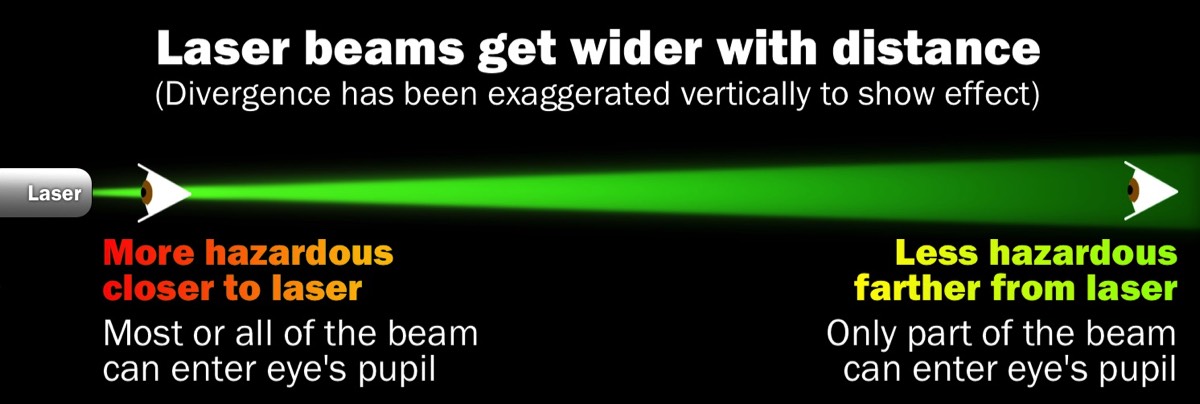 At some distance from the laser, the light intensity (irradiance) will be at the Maximum Permissible Exposure (MPE). This distance is called the Nominal Ocular Hazard Distance (NOHD):
At some distance from the laser, the light intensity (irradiance) will be at the Maximum Permissible Exposure (MPE). This distance is called the Nominal Ocular Hazard Distance (NOHD):Click to enlarge diagram
Closer than the NOHD, the irradiance is above the Maximum Permissible Exposure and is potentially hazardous. The closer a person is to the laser, the greater the potential hazard — as shown by the colors in the diagram.
At and farther than the NOHD, the laser light is generally considered eye safe. Specifically, at and farther than the NOHD there is “a negligible probability of damage” according to the laser safety standard ANSI Z136.1. The farther one gets from the NOHD, the lower the irradiance, meaning that the light is even safer. -
How to make beams safer
- A laser beam can be made safer by increasing its divergence (beam spread), lowering its power, and reducing the exposure time. The first two options are discussed below. (For reduced exposure times, see the section "What are some other MPE values?")
How divergence affects hazard distances
If a laser’s divergence is increased, the hazard distances directly decrease. For example, doubling the divergence will reduce the hazard distances by half:

Color indicates the relative hazard: Red = potential injury, green = unlikely injury. Beyond the Nominal Ocular Hazard Distance, the chance of injury is “vanishingly small” according to safety experts.
The diagrams above depict the NOHD being reduced by half. This reduction also applies to skin and fire hazard distances, and to the visual interference distances (flashblindness, glare and distraction). Doubling a laser’s divergence will reduce all of these hazard distances by half.
Usually, the more powerful a laser, the larger the typical divergence of the laser.
To increase the divergence of a beam (make it safer), use a lens to enlarge the beam. For laser light shows, a divergence of about 5 milliradians gives a larger beam without it being too “fat” or “fuzzy.”How laser power affects hazard distances
If a laser’s power is decreased, the hazard distances are shorter by the square root of the power decrease. Going from a 500 mW to a 5 mW laser is a 100 times power decrease; the hazard distances become 10 times shorter. (The square root of 100 is 10.)

This effect is a bit of good news for pilots and others concerned about increasing laser powers.
Looking at it the other way around — what is the effect of consumers obtaining more powerful lasers — the hazard distances (NOHD and visual interference) will increase less than one might expect.
A laser 100 times as powerful does not increase the NOHD hazard distance 100 times. The NOHD increases only 10 times (assuming the divergence remains the same).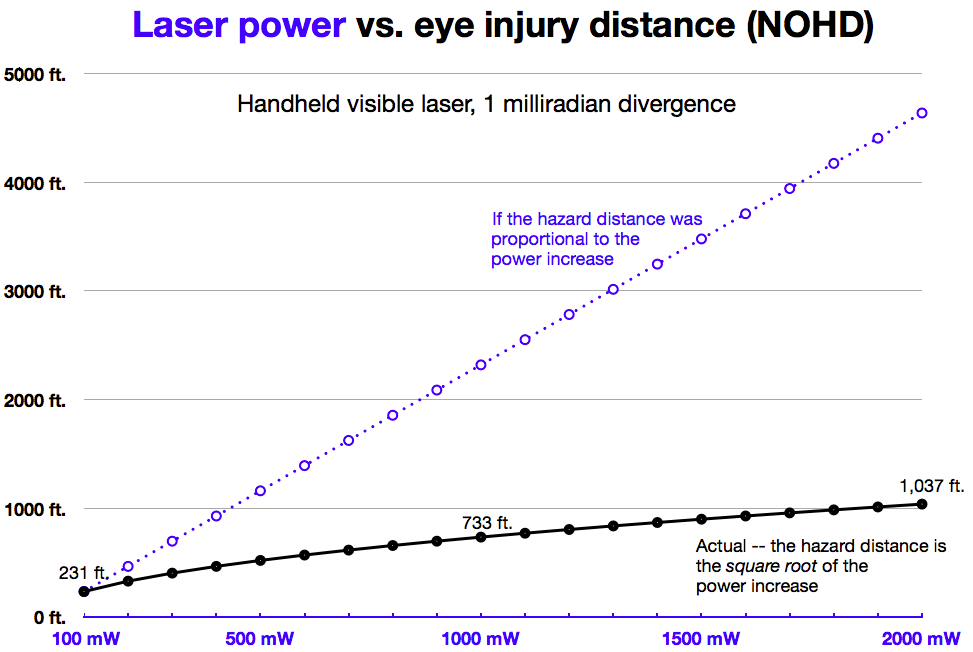
Click to enlarge diagram
Additional laser hazard calculators
We also have information about other calculators and dedicated programs. These can analyze complex situations involving multiple simultaneous colors, pulsed lasers, non-visible lasers, and/or atmospheric attenuation.
If you are a member of the International Laser Display Association, you can use ILDA’s free online Skyzan professional laser hazard calculator.

